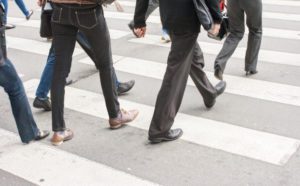We’ve all done it. Reading a text while strolling down the sidewalk. Answering a call in the crosswalk. Checking Facebook while waiting for the walk signal. These minor habits may seem harmless, but just because you’re on foot doesn’t mean you’re immune to the dangers of the road.
 Our modern reliance on smartphones creates distraction everywhere. A recent Esurance survey found that 53 percent of drivers admit to texting while driving. But it’s not only distracted drivers who pose a threat to pedestrian safety — it’s also the pedestrians themselves.
Our modern reliance on smartphones creates distraction everywhere. A recent Esurance survey found that 53 percent of drivers admit to texting while driving. But it’s not only distracted drivers who pose a threat to pedestrian safety — it’s also the pedestrians themselves.
And research suggests that the problem doesn’t just affect adults walking to work or getting some exercise. A study from the American Academy of Pediatrics found that preadolescents paid less attention to traffic and experienced more collisions and close calls when they were distracted by phones.
How do we protect pedestrians from their own bad habits in this age of constant distraction? The answer — ironically — may lie in technology. Here are three ways city planners and automakers are working to protect preoccupied pedestrians.
- Smart Cities
Earlier this year, the city of Denver, Colorado approved a $12 million investment to modernize its traffic grid, with the goal of making both motorists and pedestrians safer. They plan to accomplish this by creating a smart network of traffic signals that monitor traffic patterns, while simultaneously connecting wirelessly to smart vehicles in the vicinity.
This ability could allow the traffic system to detect pedestrians in intersections and ensure the signal doesn’t change before they’re out of harm’s way. (Plus, it could also help eliminate slowdowns and traffic jams.)
Denver isn’t the first city to invest in this kind of smart-grid technology to improve safety and traffic flow — New York City and Sydney have already been working on these improvements for years. However, it does show that pedestrian safety isn’t just a problem for mega-metropolises.
- Pedestrian Airbags
This technology puts a new spin on a tried-and-true automotive failsafe — the airbag. The idea is that when a pedestrian is either detected nearby or about to be struck by a car, airbags will deploy outside the vehicle to reduce the impact.
The first brand to bring this innovation to market was Japanese automaker Subaru, who released a model in 2017 that detects pedestrians on all sides of the vehicle and deploys an airbag over the exterior of the windshield to help protect them from injury.
American automakers like GM have filed patents for external airbags as recently as December 2017, so it likely won’t be long before these safety improvements land stateside.
- Automatic Pedestrian Detection
For the last decade or so, vehicle manufacturers have been using smart technology to improve their vehicles’ ability to detect other cars in the road. Spotting pedestrians in the road, however, has presented a bigger challenge.
The answer to this quandary uses old-school technology in a newfangled way. Recently, safety-savvy auto brands like Volvo have started to embed radar systems in the grills of their vehicles. The radar, combined with cameras mounted in the rearview mirrors, is able to spot pedestrians and cyclists from a few yards away, predict their trajectory, sound an alarm and, if necessary, activate the brakes if you get too close.
With growing numbers of both distracted drivers and distracted pedestrians, this particular type of technology could arguably become the safest, most realistic way to avoid deadly collisions. In fact, authorities in Europe have recognized its life-saving potential, encouraging automakers to further pursue these technologies.
Looking to the Future
Some of these technologies are still in their infancy, and some experimental solutions may seem downright outlandish (Google’s patent for a “glue-covered” self-driving car, for instance). But they represent creative ways that the technology, automotive and public sectors are trying to keep us all safer, both on foot and behind the wheel.
________________________
 *Eric Madia is Vice President of Product Design at Esurance, where he is responsible for designing the company’s personal lines products. Eric has 23 years of experience in the industry, focused primarily on underwriting, pricing, and product innovation. You can follow him on twitter @Erictheactuary.
*Eric Madia is Vice President of Product Design at Esurance, where he is responsible for designing the company’s personal lines products. Eric has 23 years of experience in the industry, focused primarily on underwriting, pricing, and product innovation. You can follow him on twitter @Erictheactuary.





